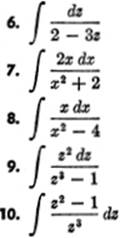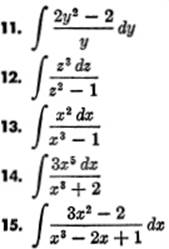The Calculus Primer (2011)
Part XII. General Methods of Integration
Chapter 45. FUNDAMENTAL PRINCIPLES OF INTEGRATION
12—3. Basic Relationships. From what has already been said, it will be seen that many integrations can be performed “by inspection.” If the reader has thoroughly mastered the fundamental formulas for derivatives, he will, with practice, be able to integrate many expressions at sight. However, we would wish to impress him with the need for having the fundamental formulas for differentiating, especially in differential notation, “at fingers’ ends.” Ready command of these formulas will go a long way toward success in integrating. Facility in integrating can be achieved only by diligent practice.
One of the basic principles for integrating is, of course, that
![]() dx = x + C, [1]
dx = x + C, [1]
which follows at once from the definitions of the symbols and the meaning of the constant of integration.
Another principle is the following:
Since ![]()
or d(av) = a dv;
therefore ![]() a dv = a
a dv = a ![]() dv. [2]
dv. [2]
Or, expressing the role played by a constant multiplier in the integrand in another way, we have,
![]() av dx = a
av dx = a ![]() v dx.
v dx.
In words, a constant factor may be removed from one side of the integration sign to the other without affecting the value of the integral. This is a very useful procedure, but the reader should be warned that this can be done only with a constant, and never with a variable. For example:
![]() 2x3 dx = 2
2x3 dx = 2 ![]() x3 dx.
x3 dx.
![]() πa2x2 dx = πa2
πa2x2 dx = πa2 ![]() x2 dx.
x2 dx.
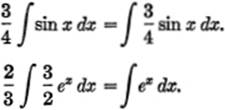
A third basic principle is the following:
![]() (du + dv − dw) =
(du + dv − dw) = ![]() du +
du + ![]() dv −
dv − ![]() dw, [3]
dw, [3]
or, in different symbolism,
![]() {f(x) + ø(x) − F(x)} dx =
{f(x) + ø(x) − F(x)} dx = ![]() f(x) dx +
f(x) dx + ![]() ø(x) dx − F(x) dx.
ø(x) dx − F(x) dx.
In words, the integral of the sum of any number of functions is equal to the sum of the integrals of the several functions. This follows, of course, from the fact that
![]()
EXAMPLE 1. Find ![]() (ax2 + bx + c) dx.
(ax2 + bx + c) dx.
Solution.
![]() (ax2 + bx + c) dx =
(ax2 + bx + c) dx = ![]() ax2 dx +
ax2 dx + ![]() bx dx +
bx dx + ![]() c dx
c dx
= a ![]() x2 dx + b
x2 dx + b ![]() x dx + c
x dx + c ![]() dx
dx
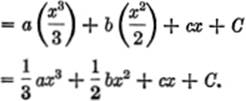
EXAMPLE 2. Find ![]()
![]()
Solution.

12—4. The Process of Integration. It is important to point out that the result of an integration does not always lead to a simple function. That is to say, performing an inverse operation in mathematics sometimes yields unusual results. Thus in arithmetic, when adding positive numbers only, the inverse operation of subtraction may lead to negative numbers, which differ in kind from the sort of numbers operated upon in arithmetic in the first place. Again, in algebra, when raising real numbers to the second power, the inverse operation of taking the square root may lead to imaginaries, a different kind of number. So in calculus: when we differentiate various so-called elementary functions (i.e., algebraic expressions resulting from the operations of addition, subtraction, multiplication, division, involution, evolution; exponential and logarithmic functions; and trigonometric functions and their inverses) the result of the differentiation contains only elementary functions; but the inverse operation of integration may yield a new kind of function, not an elementary function at all. However, in this book we shall limit ourselves to integrals which are elementary functions.
12—5. The Form ![]() Un dU. The integral of a power of a variable, when the power is not −1, is given by the following:
Un dU. The integral of a power of a variable, when the power is not −1, is given by the following:
![]()
This may be readily verified by reversing the procedure:
![]()
Thus, to integrate a variable to a given power, we increase the exponent by that amount and also divide the expression by the amount of the new exponent.
EXAMPLE 1. Find ![]() x6 dx,
x6 dx,
Solution.

EXAMPLE 2. Find ![]() ax⅓ dx.
ax⅓ dx.
Solution.
![]()
EXAMPLE 3. Find ![]()
![]()
Solution.

EXAMPLE 4. Find ![]() x¾ dx.
x¾ dx.
Solution.
![]()
EXAMPLE 5. Find ![]()
![]()
Solution.
![]()
EXAMPLE 6. Find ![]() (2a − 3x)2 dx.
(2a − 3x)2 dx.
Solution. Multiplying out first:
![]() (2a − 3x)2 dx =
(2a − 3x)2 dx = ![]() (4a2 − 12ax + 9x2) dx
(4a2 − 12ax + 9x2) dx
= 4a2 ![]() dx − 12a
dx − 12a ![]() x dx + 9
x dx + 9 ![]() x2 dx
x2 dx
![]()
= 4a2x − 6ax2 + 3x3 + C.
EXERCISE 12—1
Integrate each of the following; check your result by differentiating:
1. ![]() 8x3 dx
8x3 dx
2. ![]() 10ax4 dx
10ax4 dx
3. ![]() y4 dy
y4 dy
4. ![]() x¾dx
x¾dx
5. ![]() 2
2 ![]() dx
dx
6. ![]()
![]() x⅔ dx
x⅔ dx
7. ![]() z
z![]() dz
dz
8. ![]() 5y⅔ dy
5y⅔ dy
9. ![]() xm/n dx
xm/n dx
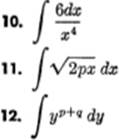

15. ![]() kz⅓ dz
kz⅓ dz
16. ![]() 2x−2 dx
2x−2 dx
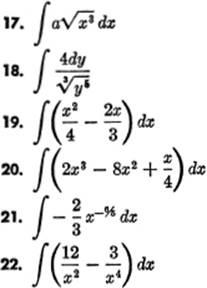
23. ![]() (x + 3)2 dx
(x + 3)2 dx
24. ![]() (3a − x2)2 dx
(3a − x2)2 dx
25. ![]() 5(x + 2)3 dx
5(x + 2)3 dx
12—6. Variations of the Form ![]() Un dU. At this point it might be well to suggest to the reader that there is no general or infallible method of finding the integral of a given function, since it is impossible always to retrace the steps of a differentiation. What we must do is this: depending upon how familiar we are with the derivative formulas, we try to recognize the given function as the derivative of some known function, or to change it to a form which can so be recognized. Every process of integration involves bringing the integrand to a form to which some standard, known formula applies. Considerable ingenuity is often required to do this.
Un dU. At this point it might be well to suggest to the reader that there is no general or infallible method of finding the integral of a given function, since it is impossible always to retrace the steps of a differentiation. What we must do is this: depending upon how familiar we are with the derivative formulas, we try to recognize the given function as the derivative of some known function, or to change it to a form which can so be recognized. Every process of integration involves bringing the integrand to a form to which some standard, known formula applies. Considerable ingenuity is often required to do this.
EXAMPLE 1. Find ![]()
![]() .
.
Solution.
![]()
Now, we may write dx = d(a + x).
Hence, the given integral may be written:
![]() (a + x)½ dx =
(a + x)½ dx = ![]() (a + x)½ d(a + x);
(a + x)½ d(a + x);
here, if we consider u = a + x, and n = ![]() , then our integral can be found by means of equation [4]:
, then our integral can be found by means of equation [4]:

EXAMPLE 2. Find ![]()
![]() .
.

EXAMPLE 3. Find ![]() (b2 − a2x2)½x dx.
(b2 − a2x2)½x dx.
Solution. We note that
d(b2 − a2x2) = −2a2x dx.
Multiplying inside the integral sign by −2a2, and dividing outside by −2a2, leaves the integral unchanged in value, but transforms it to the form ![]() un du, where u = (b2 − a2x2), and n =
un du, where u = (b2 − a2x2), and n = ![]() ;
;
hence,

EXAMPLE 4. Find ![]() (x3 + 1)2x2 dx.
(x3 + 1)2x2 dx.
Solution. We can first multiply out:
![]() (x3 + 1)2x2 dx =
(x3 + 1)2x2 dx = ![]() (x6 + 2x3 + 1)x2 dx
(x6 + 2x3 + 1)x2 dx
= ![]() (x8 + 2x5 + x2)dx
(x8 + 2x5 + x2)dx
![]()
Or, an alternative, more elegant solution. Since d(x3 + 1) = 3x2 dx, we may replace the “x2 dx” in the original problem by “![]() d(x3 + 1)”; thus
d(x3 + 1)”; thus

We leave it to the reader to verify the fact that the right-hand members of (1) and (2), respectively, will both check when differentiated.
EXERCISE 12—2
Integrate; check by differentiating:
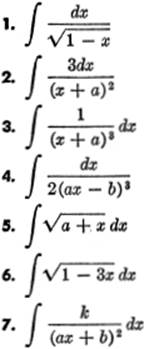
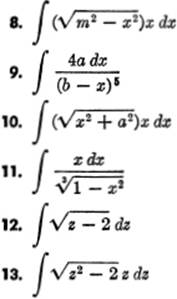
14. ![]() (m + x)(a + x) dx
(m + x)(a + x) dx
15. Integrate ![]() (x4 − 1)2x3 dx in two ways, explain why the results are not identical, and show that both are correct.
(x4 − 1)2x3 dx in two ways, explain why the results are not identical, and show that both are correct.
12—7. The Form ![]()
![]() . The integral of the reciprocal of a variable is the logarithm of the variable; or
. The integral of the reciprocal of a variable is the logarithm of the variable; or
![]()
This, of course, is readily verified by differentiation; thus,
![]()
NOTE. Strictly speaking, we should write ![]()
![]() = log |u| + C, since, although
= log |u| + C, since, although ![]() is defined for all values of u ≠ 0, log u is defined only for values of u > 0.
is defined for all values of u ≠ 0, log u is defined only for values of u > 0.
EXAMPLE 1. Find ![]()
![]() .
.
Solution.
![]()
EXAMPLE 2. Find ![]()
![]()
Solution. Since, from the definition of a differential, we may write, if we care to, dx = d(x + 1).
Hence ![]()
where we are regarding u as equal to x + 1, and
![]() = 1, or du = 1(dx) = dx.
= 1, or du = 1(dx) = dx.
By differentiating the answer, the result is seen to check; thus
![]()
In fact, whenever the numerator of an integrand is (or can be made) the differential of the denominator, the integral is the logarithm of the denominator.
EXAMPLE 3. Find ![]()
![]() .
.
Solution. d(x2 + 1) = 2x.
Rewrite the given example:
![]()
now, considering u as x2 + 1, and ![]() as 2x, or du = 2x dx, we have:
as 2x, or du = 2x dx, we have:
![]()
EXAMPLE 4. Find ![]()
![]()
Solution. First rewrite the integral as follows:

EXERCISE 12—3
Find the following integrals; check by differentiation:

